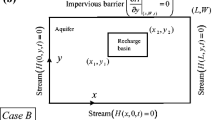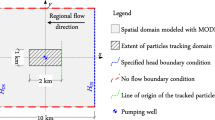Abstract
The purpose of this work is to present analytical solution for linearized Boussinesq equation in triangular-shaped aquifers in response to transient recharge from an overlaying basin. Four different configurations of hydrogeological boundary conditions (constant-head and no-flow) are considered. At first, the solutions for the rectangular-shaped aquifers are obtained through the well known image well theory. Then, the concept of expanded domain is utilized to arrive at the solution for the intended triangular domain. The resulting point-recharge solution (Green’s function) facilitates treating any arbitrary shaped recharge basin subjected to spatiotemporal varying recharge. Few examples describing the nature of transient recharge in triangular-shaped aquifers are presented. The investigation of equipotential contour lines and velocity vector fields confirms the validity of the method adopted here. The computed mound profiles are in favourably well agreement with the numerical results obtained by finite element method. Stream flow rates due to recharging are also computed for a single case. Overall, the closed form solutions provide an effective tool in order to conduct sensitivity analysis on various hydrogeological parameters that affect the formation of groundwater mound in triangular-shaped aquifers.












Similar content being viewed by others
References
Asadi-Aghbolaghi M, Seyyedian H (2010) An analytical solution for groundwater flow to a vertical well in a triangle-shaped aquifer. J Hydrol 393:341–348
Berg M, Stengel C, Trang PTK, Viet PH, Sampson ML, Leng M, Samreth S, Fredericks D (2007) Magnitude of arsenic pollution in the Mekong and Red River Deltas—Cambodia and Vietnam. Sci Total Environ 372:413–425
Blaszkowiak S, Kaczkowski Z (1966) Iterative methods in structural analysis. Pergamon, Oxford
Chan YK, Mullineux N, Reed JR, Wells GG (1978) Analytic solutions for drawdowns in wedge-shaped artesian aquifers. J Hydrol 36:233–246
Ferris JG, Knowles DB, Brown RH, Stallman RW (1962) Theory of aquifer tests. Ground-Water Hydraulics, Geological Survey, Water-Supply Paper 1536-E
Hantush MS (1967) Growth and decay of ground water mounds in response to uniform percolation. Water Resour Res 3(1):227–234
Liang X, Zhang YK (2012) Analytical solution for drainage and recession from an unconfined aquifer. Ground Water 50(5):793–798
Manglik A, Rai SN (1998) Two-Dimensional modelling of water table fluctuations due to time-varying recharge from rectangular basin. Water Resour Manage 12:467–475
Manglik A, Rai SN (2000) Modeling of water table fluctuations in response to time-varying recharge and withdrawal. Water Resour Manage 14:339–347
Manglik A, Rai SN, Singh VS (2004) Modelling of aquifer response to time varying recharge and pumping from multiple basins and wells. J Hydrol 292:23–29
Manglik A, Rai SN, Singh VS (2013) A generalized predictive model of water table fluctuations in anisotropic aquifer due to intermittently applied time-varying recharge from multiple basins. Water Resour Manage 27:25–36
Marino MA (1974) Growth and decay of groundwater mounds induced by percolation. J Hydrol 22:295–301
Polubarinova-Kochina PY (1962) Theory of ground water movement. Princeton University Press, Princeton
Rai SN, Manglik A (1999) Modelling of water table variation in response to time-varying recharge from multiple basins using the linearised Boussinesq equation. J Hydrol 220:141–148
Rai SN, Manglik A (2012) An analytical solution of Boussinesq equation to predict water table fluctuations due to time varying recharge and withdrawal from multiple basins, wells and leakage sites. Water Resour Manage 26:243–252
Rai SN, Manglik A, Singh VS (2006) Water table fluctuation owing to time-varying recharge pumping and leakage. J Hydrol 324:350–358
Rai SN, Singh RN (1996) On the prediction of groundwater mound formation due to transient recharge from a rectangular area. Water Resour Manage 10:189–198
Rai SN, Singh RN (1998) Evolution of the water table in a finite aquifer due to transient recharge from two parallel strip basins. Water Resour Manage 12:199–208
Rao NH, Sarma PBS (1981) Groundwater recharge from rectangular areas. Ground Water 19(3):271–274
Rao NH, Sarma PBS (1983) Recharge to finite aquifers from strip basins. J Hydrol 66:245–252
Samani N, Zarei-Doudeji S (2012) Capture zone of a multi-well system in confined and unconfined wedge-shaped aquifers. Adv Water Resour 39:71–84
Warner JW, Molden D, Chehata M, Sunada DK (1989) Mathematical analysis of artificial recharge from basin. Wat Resour Bull 25(2):401–411
Yeh H-D, Chang Y-C (2006) New analytical solutions for groundwater flow in wedge-shaped aquifers with various topographic boundary conditions. Adv Water Resour 29:471–480
Yue-zan T, Mei Y, Bing-feng Z (2007) Solution and its application of transient stream/groundwater model subjected to time-dependent vertical seepage. Appl Math Mech 28(9):1173–1180
Zomorodi K (1991) Evaluation of the response of a water table to a variable recharge. Hydrol Sci J 36:67–78
Acknowledgment
The authors wish to thank Dr. M. Reza Hashemi (CAMS, School of Ocean Sciences, Bangor University, UK) for his technical help in MATLAB computations performed in this study.
Author information
Authors and Affiliations
Corresponding author
Appendix A
Appendix A
Referring to Fig. 13, the periodic well pattern has the same periodicities of 4L along both coordinate axes with a building block containing 32 point-wells. In addition, the well pattern possesses odd-symmetry about x-axis and even-symmetry about y-axis. This allows a typical point-well to be expressed by double Fourier series as follows:
with (x i , y i ) being the position of a typical point-well. Here, ε = +1 and ε = −1 identify the recharge and discharge well, respectively, also
The coordinate system has its origin at the lower left corner of the aquifer. Evaluating Eq. (A-1) for each individual well (i = 0,1,…,31) and adding the resulting expressions together after some algebraic manipulations gives:
In deriving Eq. (A-3) some trigonometric identities such as \( \sin \left( {{{{m\pi }} \left/ {2} \right.}} \right)\sin \left( {{{{n\pi }} \left/ {2} \right.}} \right)=\left( {{-1 \left/ {4} \right.}} \right)\left[ {\left( {1-{{{\left( {-1} \right)}}^m}} \right)\left( {1-{{{\left( {-1} \right)}}^n}} \right)} \right]\times {{\left( {-1} \right)}^{{\frac{m+n }{2}}}} \) were used. Equation (A-3) identically vanishes if m or n is not an odd integer, otherwise, it simplifies to:
where T 3(x, y) is given by Eq. (31) and the summations are taken over odd values of m and n. Similarly, the expression for the Green’s function is simplified to:
repeating the same expression as for Eq. (30).
Rights and permissions
About this article
Cite this article
Mahdavi, A., Seyyedian, H. Transient-State Analytical Solution for Groundwater Recharge in Triangular-Shaped Aquifers Using the Concept of Expanded Domain. Water Resour Manage 27, 2785–2806 (2013). https://doi.org/10.1007/s11269-013-0315-2
Received:
Accepted:
Published:
Issue Date:
DOI: https://doi.org/10.1007/s11269-013-0315-2





